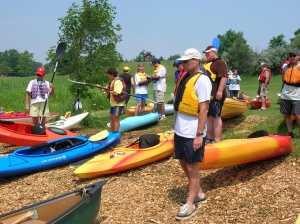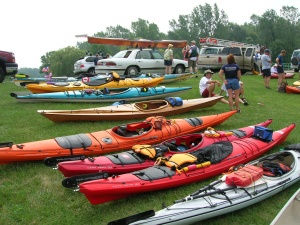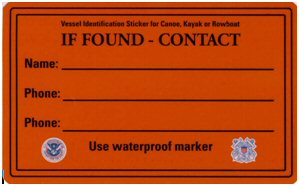Difference between revisions of "Paddlesports"
Brucejohnson (Talk | contribs) (→Internet resources) |
Brucejohnson (Talk | contribs) (→Auxiliary resources) |
||
| Line 98: | Line 98: | ||
* [http://safetyseal.net/pdf_files/ColdWaterSurvival-USCGAux.pdf Practices, Ethics and Conduct] | * [http://safetyseal.net/pdf_files/ColdWaterSurvival-USCGAux.pdf Practices, Ethics and Conduct] | ||
| − | ==Auxiliary | + | ==Auxiliary services to paddlers== |
* [[Canoeing and Kayaking]] (for Boy Scouts) | * [[Canoeing and Kayaking]] (for Boy Scouts) | ||
* [http://www.cgaux.org/boatinged/classes/paddlesports.html Paddlesports America] | * [http://www.cgaux.org/boatinged/classes/paddlesports.html Paddlesports America] | ||
Revision as of 15:52, 6 February 2011
| intro intro intro |
Contents |
Paddlesports News
Auxiliary Promotes Paddlesports Safety
The American Canoe Association (ACA) and the U.S. Coast Guard Auxiliary announced signing of a Memorandum of Agreement to promote safety among those who use kayaks, canoes and other paddlecraft. The new agreement establishes cooperative efforts broadening outreach and education to the paddle sports community. Paddlesports boating is one of the fastest growing recreational activities in the United States. In 2008 the Outdoor Industry Association reported that approximately 17.8 million people participated in paddlesports, getting out on the water nearly 50,000 times daily. Read More >>
Memorandum of Agreement
This Memorandum of Agreement (MOA) is entered into by the American Canoe Association and the U.S. Coast Guard Auxiliary for the purpose of establishing a framework for a cooperative relationship under which the U.S. Coast Guard Auxiliary (Auxiliary) and the American Canoe Association (ACA) will assist one another in areas of mutual objectives.
This Agreement is authorized under the provisions of 14 United States Code, Section 821 through 832, the Code of Federal Regulations, Title 33, Part 5 and COMDTINST M 16790.1F (Auxiliary Manual) which establish promoting and improving recreational boating safety as a priority of the Coast Guard Auxiliary and authorize entering into agreements with States, local government and private entities to enhance boating safety. The American Canoe Association, Inc. is authorized by its National Bylaws to enter into to this agreement.
The Auxiliary and ACA share similar concerns and responsibilities for educating members in a wide variety of boating and nautical subjects. This agreement will encourage the agencies to communicate and to share information and training. Specific activities to be conducted under this MOA will be defined on a case-by-case basis by the ACA and the Auxiliary. Each Party may collaborate in the conduct of a broad range of domestic projects that support recreational boating safety, including but not limited to Public Education Programs, Vessel Safety Checks, Water Safety Education Outreach, and Volunteer support.
- A representative from each Party at the headquarters level may regularly provide each other updates through written correspondence, coordination meetings, and other mechanisms on program activities, training, development and related work pertaining to cooperative activities pursued under this MOA.
- Any ACA local group may establish local, volunteer working relationships with the local Auxiliary to support training and to promote recreational boating and water safety. Any local Auxiliary group may establish local, volunteer working relationships with the local ACA group to support training and to promote recreational boating and water safety.
- Nothing in this MOA shall be construed to require the ACA to use the Auxiliary or for the ACA to be responsible for conducting Auxiliary programs. Nothing in this MOA shall be construed to require the Auxiliary to use the ACA or for the Auxiliary to be responsible for conducting ACA programs.
- Each Party will work cooperatively in the exchange of applicable data, information, and products.
- Each Party will cooperate on joint outreach and educational activities that may involve other partners of either organization.
- the activities conducted under this MOA may be documented and made available through appropriate journals, publications, and other established channels, consistent with good scientific practice. Publications documenting cooperative efforts may be prepared by either Party, or jointly, provided that each Party is given an opportunity to review and concur with manuscripts prior to publication.
- The Parties agree that sharing credit is mutually beneficial and will assure that appropriate citation and attribution is given for work performed under this MOA. Uses of a Party’s logo or seal, however, will require advance approval by that Party.
- Amendment. This MOA may be modified or amended by mutual agreement of each Party in writing.
- Other Provisions. Nothing in this Agreement is intended to conflict with current law or regulation or the directives of the Department of Homeland Security. If a term of this agreement is inconsistent with such authority, then that term shall be invalid, but the remaining terms and conditions of this agreement shall remain in full force and effect.
- Duration. This MOA may be terminated at any time by mutual written agreement of Parties or by either Party upon 90 days written notice to the other Party. Otherwise this MOA will remain in effect indefinitely.
Implementation Plan
The American Canoe Association (ACA) and U.S. Coast Guard Auxiliary (Auxiliary) recognize the value and importance of working together to further our common interest in promoting recreational boating safety (RBS) within the paddlesport community. This plan outlines implementation strategies that will advance the goals set forth in the Memorandum of Agreement (MOA) between the ACA and the Auxiliary.
General provisions
- Explore measures that will foster an enduring partnership between the Auxiliary instructors and vessel examiners and their counterparts in the ACA.
- To be fully effective when interfacing with the paddlesports community every effort should be made to establish partnerships at either the District, Division, or Flotilla levels of the Auxiliary.
- Both the ACA and the Auxiliary possess resources and expertise that can enhance the paddlesports education experience thus making advantageous to work in a team setting.
- Resources within the ACA and Auxiliary that will advance the goals of RBS within the paddlesports community will be identified and shared as needed.
- With the assistance of the ACA the AuxBWiki will be developed as a paddlesports resource.
- The Auxiliary will designate a liaison representative to serve on the ACA National Safety Education and Instruction Council (SEIC).
- The ACA will be invited to assist the Auxiliary leadership in the training of its members who will be directly involved in the various RBS programs for paddlesports. Assimilating the necessary paddling skills and expertise is essential for instructor development and effective management of the paddlecraft vessel safety check program. ACA involvement may occur at any organization level of the Auxiliary.
- All available media resources of the ACA and the Auxiliary will be used to raise safety awareness within the paddlesports community. Media releases will be jointly prepared in order to give both organizations an opportunity to promote their respective mission areas.
Administrative responsibilities
- Effective communication is essential to the success of the partnership between the ACA and the Auxiliary.
- Auxiliary points of contact will be designated at the national level and a liaison to the ACA will be appointed to nurture the partnership with the Auxiliary.
- Communication between the ACA and Auxiliary Districts, Divisions or Flotillas for the purposes of advancing the goals of the MOA is strongly encouraged.
Interaction with Auxiliary Districts
- The ACA is administratively organized into 14 divisions each of which has a staffed instructional facility. Throughout the ACA there are 4,500 certified instructors that are listed on a searchable internet based directory. This broad geographic representation will present ample opportunity for interaction with Auxiliary Districts.
- To assist the Auxiliary with instructor development and the training of paddlecraft vessel safety examiners the ACA will seek out grants for funding that will be used to provide advanced classroom and on-water skill training. Conversely, the Auxiliary will explore the possibility of training ACA members so that they can participate in the paddlecraft vessel safety check program.
- Recognizing that the ACA is an important partner, the Auxiliary is encouraged to solicit their involvement in district training conferences. When conducting training a team teaching approach should be utilized using ACA and Auxiliary instructors. Joint training opportunities are not limited to the District level and may occur at the Division or Flotilla levels.
- The establishment of local working partnerships is strongly encouraged. ACA members should be invited to assist in a team teaching setting when presenting the Auxiliary Paddlesports America Course.
- Public outreach efforts intended to promote Recreational Boating Safety within the paddlesports community should be presented jointly by members of the ACA and the Auxiliary.
- The ACA and the Auxiliary will work together to develop media products that will help raise safety awareness within the paddlesports community. Both the ACA and the Auxiliary agree that periodic media releases are necessary to maintain awareness levels.
- The Auxiliary will explore the possibility of establishing paddlesports advocates within Districts, Divisions and Flotillas. The advocate will help identify and facilitate ACA/Auxiliary involvement in paddling events and activities for the purpose of advancing recreational boating safety within the paddlesports community.
Vessel examination
- Paddlecraft Vessel Examiners will be jointly trained by ACA and Auxiliary instructors. Auxiliary Vessel Examiners will be encouraged to complete ACA classroom or on-water training sessions.
- As various paddlesports resources are developed to support the paddlecraft Vessel Safety Check program the ACA will be invited to participate in their development and review.
- The Auxiliary recognizes the value of having ACA instructors perform paddlecraft Vessel Safety Checks. A program will be established to provide the necessary training and certification. Once trained ACA and Auxiliary members will be expected to work jointly to advance the goals of the Vessel Safety Check program.
Resources
Public education
- Auxiliary instructors are encouraged to team teach the Paddlesports America course with ACA instructors.
- Instructor development is essential for success. Auxiliary instructors will be encouraged to complete ACA classroom or on-water training sessions.
Resources
Auxiliary articles
- Paddling into History, Navigator, Winter 2004
- Engaging the Paddlesports Community, The Eastwind (Ninth Eastern), Summer 2010
Brochures
- Best Practices for Paddlers and Paddlesports Programs
- Paddler's Safety Checklist
- Wear It! Lifejackets Matter
- Cold Water Survival
- Practices, Ethics and Conduct
Auxiliary services to paddlers
- Canoeing and Kayaking (for Boy Scouts)
- Paddlesports America
- Paddlesports American Power Point Presentations
- Paddlecraft Vessel Safety Check (Form 7012A)
Reading list
The Reading List is a compilation of print and web resources that will be of useful to instructors, vessel examiners and others involved in paddlesports safety. This list is a living document that will evolve as time goes on.
Kayak resources
- Alderson, Doug. Sea-Kayakers Savvy Paddler. Camden: Ragged Mountain Press, 2001.
- Burch, David. Fundamentals of Kayak Navigation. Old Saybrook: Globe Pequot Press, 1993.
- Diaz, Ralph. Complete Folding Kayaker. Camden: Ragged Mountain Press, 1994
- Dillon, Pamela and Jeremy Oyen, eds. Kayaking, Champaign, IL: Human Kinetics, 2009.
- Dowd, John. Sea Kayaking, A Manual for Long Distance Touring. Vancouver: Douglas & McIntyre Ltd, 1988.
- Gronseth, George and Matt Broze. Sea-Kayaker Deep Trouble and Their Lessons. Camden: Ragged Mountain Press, 1997.
- Gullion, Laurie. Canoeing and Kayaking Instruction Manual. Birmingham: Menasha Ridge Press, 1987.
- Hutchinson, Derek. Eskimo Rolling. Camden: Ragged Mountain Press, 1992.
- Hutchinson, Derek C. Expedition Kayaking on Sea and Open Water. Old Saybrook: Globe Pequot Press, 1995.
- Johnson, Shelley. The Complete Sea Kayaker’s Handbook. Camden: Ragged Mountain Press, 2002.
- Killen, Ray. Simple Kayak Navigation. Camden: Ragged Mountain Press, 2006.
- Robison, John. Sea Kayaking Illustrated, A Visual Guide to Better Paddling. Camden: Ragged Mountain Press, 2003.
- Seidman, David. The Essential Sea Kayaker: A Complete Course for the Open Water Paddler. Camden: Ragged Mountain Press, 1992.
- Wyatt, Mike. The Basic Essentials of Sea Kayaking. Old Saybrook: Globe Pequot Press 1990.
Canoe resources
- Dillon, Pamela, ed. Canoeing. Champagne, IL: Human Kinetics, 2009.
- Foster, Nigel. Open Canoe Technique. Guilford, CT. Falcon Guide, 2004.
- Jacobson, Cliff. The Basic Essentials of Solo Canoeing, Merrilleville, IN. ICS Books, Inc. 1991.
- Mason, Bill. Path of the Paddle. Buffalo, NY. Firefly Books. 1999.
- McGuffin, Gary and Joan McGuffin. Paddle Your Own Canoe. Ontario: Boston Mills Press, 2005.
- Ray, Slim. The Canoe Handbook. Harrisburg: Stackpole Books, 1992.
- Rounds, John, ed. Basic Canoeing. Mechanicsburg: Stackpole Books, 2003.
External links
- Adirondack Mountain Club
- American Canoe Association
- Canoe and Kayak Magazine
- Folding Kayaks
- Kayaking for Beginners
- Kayak Paddling .net
- Kayak Zak’s Adaptive Paddling
- Kayarchy
- Northeast Paddlers Message Board
- Northern Forest Canoe Trail
- Paddler Magazine
- Paddling.About.com
- Paddling Instructor.com
- Paddling.net
- Paddlewise
- Sea Kayaker Magazine
- Wekanu
- Western New York Paddlers Group
Media sources
- Adventure Kayak Magazine
- Backpacker Magazine
- Canoe and Kayak Magazine
- Canoe Sailing Magazine
- Family and Camping Canoeroots Magazine
- Kayak Angler Online
- Kayak Fishing Magazine
- Kayak Fishing.com
- Kayak Magazine
- Ocean Paddler Magazine
- Paddling Life
- Paddling.net
- Rapid the Whitewater Magazine
- Sea Kayaker Magazine
- Stand Up Paddle Surfing Magazine
- USCA Canoe News
- Wavelength Magazine
Contributed by
Paul Leuchner, BC-BLC, American Canoe Association Branch Chief


